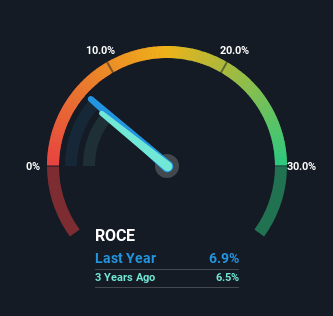Slowing Rates Of Return At Johnson Controls International (NYSE:JCI) Leave Little Room For Excitement
What trends should we look for it we want to identify stocks that can multiply in value over the long term? One common approach is to try and find a company with returns on capital employed (ROCE) that are increasing, in conjunction with a growing amount of capital employed. This shows us that it's a compounding machine, able to continually reinvest its earnings back into the business and generate higher returns. However, after briefly looking over the numbers, we don't think Johnson Controls International (NYSE:JCI) has the makings of a multi-bagger going forward, but let's have a look at why that may be.
Understanding Return On Capital Employed (ROCE)
For those who don't know, ROCE is a measure of a company's yearly pre-tax profit (its return), relative to the capital employed in the business. Analysts use this formula to calculate it for Johnson Controls International:
Return on Capital Employed = Earnings Before Interest and Tax (EBIT) ÷ (Total Assets - Current Liabilities)
0.069 = US$2.1b ÷ (US$43b - US$14b) (Based on the trailing twelve months to March 2024).
Thus, Johnson Controls International has an ROCE of 6.9%. Ultimately, that's a low return and it under-performs the Building industry average of 17%.
Check out our latest analysis for Johnson Controls International
In the above chart we have measured Johnson Controls International's prior ROCE against its prior performance, but the future is arguably more important. If you're interested, you can view the analysts predictions in our free analyst report for Johnson Controls International .
The Trend Of ROCE
Over the past five years, Johnson Controls International's ROCE and capital employed have both remained mostly flat. It's not uncommon to see this when looking at a mature and stable business that isn't re-investing its earnings because it has likely passed that phase of the business cycle. So don't be surprised if Johnson Controls International doesn't end up being a multi-bagger in a few years time. With fewer investment opportunities, it makes sense that Johnson Controls International has been paying out a decent 36% of its earnings to shareholders. Given the business isn't reinvesting in itself, it makes sense to distribute a portion of earnings among shareholders.
What We Can Learn From Johnson Controls International's ROCE
We can conclude that in regards to Johnson Controls International's returns on capital employed and the trends, there isn't much change to report on. Since the stock has gained an impressive 79% over the last five years, investors must think there's better things to come. But if the trajectory of these underlying trends continue, we think the likelihood of it being a multi-bagger from here isn't high.
Since virtually every company faces some risks, it's worth knowing what they are, and we've spotted 3 warning signs for Johnson Controls International (of which 1 shouldn't be ignored!) that you should know about.
While Johnson Controls International may not currently earn the highest returns, we've compiled a list of companies that currently earn more than 25% return on equity. Check out this free list here.
Have feedback on this article? Concerned about the content? Get in touch with us directly. Alternatively, email editorial-team (at) simplywallst.com.
This article by Simply Wall St is general in nature. We provide commentary based on historical data and analyst forecasts only using an unbiased methodology and our articles are not intended to be financial advice. It does not constitute a recommendation to buy or sell any stock, and does not take account of your objectives, or your financial situation. We aim to bring you long-term focused analysis driven by fundamental data. Note that our analysis may not factor in the latest price-sensitive company announcements or qualitative material. Simply Wall St has no position in any stocks mentioned.
Have feedback on this article? Concerned about the content? Get in touch with us directly. Alternatively, email editorial-team@simplywallst.com

 Yahoo Finance
Yahoo Finance 
